Posted on September 22, 2010 at 2:55 pm
The Many Faces of Elie Wiesel
By Carolyn Yeager
copyright 2010 Carolyn Yeager
Elie Wiesel has been identified – in some cases has identified himself – in these three photographs. A close examination brings up many questions.
Do any two of these pictures look like the same person? You might think that picture #2 or 3 has a vague resemblance to picture #1, but pictures 2 and 3 don’t in the least resemble each other. The man in picture #2 has a sharp aquiline nose, high cheekbones, full lips and looks quite a bit older than 16 years of age, while the round-headed lad in picture #3 has a wide face, short nose and low forehead. He looks younger than 16.
Picture #2 can be recognized as a close-up from the Famous Buchenwald Liberation Photo. [see page under The Evidence]. Weasel has maintained since the 1980’s that this is his face.
Picture #3 is taken from the photograph below. He is the boy in front of the tall boy in the left column of boys leaving Buchenwald, fourth from the front (the third boy in line is hidden from view). He’s been identified as Elie Wiesel by Prof. Kenneth Waltzer on his Michigan State University website. Wiesel has not denied it. The U.S. Holocaust Memorial Museum, however, doesn’t claim that Elie is in this picture (see USHMM below).
Above: Children march out of Buchenwald to a nearby American field hospital where they will receive medical care. Buchenwald, Germany, April 27, 1945. — Wide World Photo [Photo and caption from USHMM website]
Below: From Ken Waltzer’s MSU Newsroom Special Report page
Elie Wiesel at Buchenwald
Elie Wiesel is fourth on the left, in front of the tall youth with beret.
Picture courtesy of the late Jack (Yakov) Werber, Great Neck, New York.
Waltzer writes on this same page:
In “Night,” Wiesel says that when he viewed himself in a mirror after liberation, he saw a corpse gazing back at him. But another picture [the one above] taken after liberation on April 17 [he has the date wrong], when the boys were led to the former SS barracks outside the camp, shows Wiesel marching out, fourth on the left, among a phalanx of youth moving together, heads held high, a group together guided by prisoners who had helped save them.
According to Waltzer, Elie Wiesel had a fast recovery to health, body mass and optimism, which Elie himself has never claimed. According to Buchenwald documents, these youths were not sent to France until July 16, 1945 (Fig. 12.4, 12.5),
Waltzer teaches German history and directs the Jewish Studies Program at MSU which includes courses on the Holocaust. He is writing a book about the orphan boys at Buchenwald titled “The Rescue of Children at Buchenwald.” Will Prof. Waltzer offer an explanation in his book for Elie Wiesel’s fit appearance in this photograph? He also accepts the man in the barracks photo as 16-year-old Wiesel. But then he has to, doesn’t he. How will he reconcile these two faces only eleven days apart?
USHMM
The USHMM features the picture shown below on its website—which Waltzer also refers to—and tells us that Elie Wiesel is among these boys without pointing out which one he is. Failing to find anyone who resembles Elie, I wrote to the USHMM asking them to identify him, but received no reply. [Update – because of a reader and also other pictures of Wiesel in France that surfaced later, I now believe Wiesel could be the darkish face in the 2nd to the last row, looking over the shoulder of the boy in a military-looking jacket and to the left of two boys in light-colored caps or berets. ]
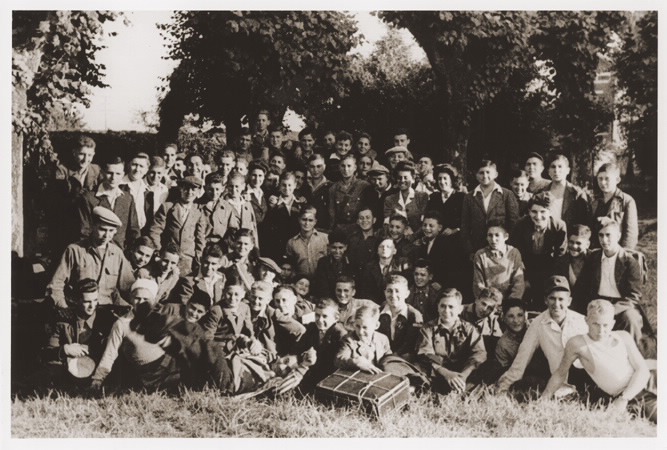 Group portrait of Jewish displaced youth at the OSE (Oeuvre de Secours aux Enfants) home for Orthodox Jewish children in Ambloy. Elie Wiesel is among those pictured. Ambloy, France, 1945. — USHMM, courtesy of Willy Fogel
Group portrait of Jewish displaced youth at the OSE (Oeuvre de Secours aux Enfants) home for Orthodox Jewish children in Ambloy. Elie Wiesel is among those pictured. Ambloy, France, 1945. — USHMM, courtesy of Willy Fogel
The U.S. Holocaust Museum dates this picture simply as 1945. It is definitely summer; the boys are dressed in their suits and “traveling clothes,” as if they had just arrived. A large suitcase is being held by a young boy seated in the front row. It fits in every respect the records for the Buchenwald transport that left Germany for France on July 16, 1945.
Wiesel is careful not to give dates for many important events in his memoir All Rivers Run to the Sea. In this book he writes in detail about his trip to France and his early years with the Oeuvre de Secours. Yet he gives not a single date, until he mentions that he first met his future mentor, Shushani, sometime in 1947.1 He writes of being active with the other Jewish youths – engaged in classes, choir practice, trips and flirtations – but strangely not a single photograph is available.
The next picture of Elie Wiesel I have found was taken in 1949. In fact, it is the first picture of him we can be sure of since the 15-year-old portrait of 1944, prior to deportation (picture #1). Why are there no pictures of Wiesel during all the years he was in the Jewish welfare system in France? We are told his sister Hilda, living in Paris, recognized him in 1945 in a photograph of OSE orphans that was published in a newspaper or magazine. What picture was that? [This question was finally answered. See http://www.eliewieseltattoo.com/another-photo-of-young-elie-wiesel-that-is-not-elie-wiesel/ The group photo above? There are no easy or available answers to these questions. It doesn’t take much imagination, however, to consider that it’s because there aren’t any that “fit” the story.
I find it more than ironic that on the page “Elie Wiesel Timeline and World Events, 1928-1951” there are three photographs and Elie Wiesel is not in any one of them!
The next picture I can find of Elie Wiesel was taken in 1949, on a ship heading for Israel. We see here the real Elie – long, narrow face, long nose (but not aquiline as in picture #2 above), large ears, high broad forehead, a slender build. He is 20 years old and a journalist, and has probably never looked better. [Maybe that’s why the picture was released.] We learn in his memoir that on May 14, 1948, when David Ben Gurion read out the Israel Declaration of Independence, Elie Wiesel had been working already for around six months for the Irgun Yiddish weekly newspaper Zion in Kamf (Zion in Struggle)– yes, Irgun, the terrorist gang. He remained with the Irgun until they closed their European offices in January 1949. He was then persuaded to go where the action was—to Israel. Helped by the Jewish Agency, and traveling with a few Irgun veterans, he boarded the ship Negba in May or June (uncertain), crossing to Haifa, Israel.2 This picture must have been taken during that trip.
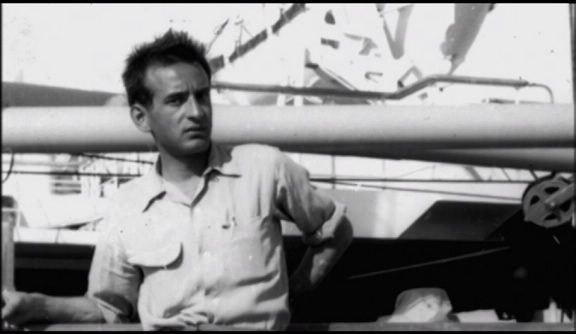 Elie Wiesel on a boat to Israel in 1949
Elie Wiesel on a boat to Israel in 1949
These are the faces of young Elie Wiesel during his “years of travail” that we have at our disposal—not much. I offer the opinion that too much is missing to accept unquestionably the story of his life, during these years 1944-1950, that has been manufactured for public consumption. Only two pictures: before Auschwitz and after his connection with the orphanage was concluded, are definitely him. The search continues.
Endnotes:
- Elie Wiesel, All Rivers Run to the Sea, Alfred Knopf, 1995, p 121.
- ibid, pg. 174-180
Categories Featured | Tags: Buchenwald liberation, Irgun, Ken Waltzer, Oeuvre de Secours, Shushani/Chouchani, USHMM
Leave a Reply
By submitting a comment here you grant Elie Wiesel Cons the World a perpetual license to reproduce your words and name/web site in attribution. Inappropriate or irrelevant comments will be removed at an admin's discretion.

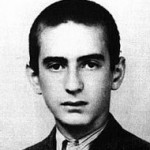
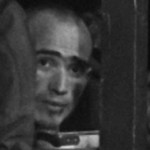
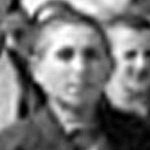
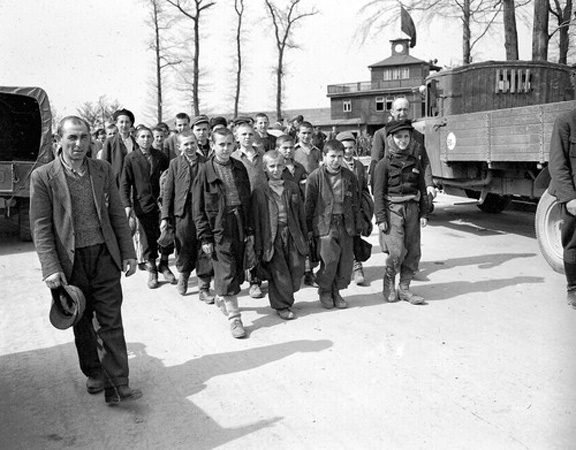
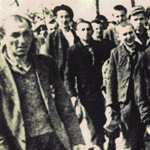

14 Comments to The Many Faces of Elie Wiesel
by Shelby
On November 24, 2010 at 3:31 pm
Picture #2 and #3 hardly resemble eachother, and the fact that they are only 10 days apart seems odd to me. Can someone’s face change so much in so little time?
As for the group picture, you can’t see many of the faces clearly in the photo, so Wiesel could have very well been “hiding”.
Do look to the far right in the photo at the young boy in the middle-the one above the boy in the muscle shirt. I see a slight resemblance to Wiesel photo #1? (nose, eyes, slender face..) Of course I could be wrong. Also not understanding why Weiesel himself wouldn’t have pointed this out if it was him.
by Carolyn
On November 26, 2010 at 1:21 pm
Shelby:
In the group picture, the boy you point out doesn’t appear to be Wiesel in my opinion, though I can see the vague resemblance you have noticed. However you make a great point when you say ‘if that were him, he and the USHMM would have pointed it out.’ Indeed they would. So would Prof. Ken Waltzer who is writing a book, so he keeps saying, about the Jewish orphans sent to the Jewish OSE in France, of whom Elie Wiesel was supposedly one. If they can’t tell us which one is Elie, why say he’s there at all? I guess they take us for being really stupid and gullible.
by sam
On December 31, 2010 at 8:09 pm
Obviously his cheekbones and nose were thinner.
Elie Wiesel, along with the other victims were STARVED. Of course he’s going to look different. I have a friend who starves herself, and before she was normal weight, but now she looks alot different because her body and face are so thin
by Carolyn
On January 4, 2011 at 1:39 pm
sam,
What is “obvious” about cheekbones and noses becoming thinner? Noses are not made of fat, but of some kind of cartilage. Does a “starved” person’s nose change shape, as the noses we see in the pictures are different shapes? Do their cheekbones move around in their face? Does their skull change shape? I don’t think you can say that about your girlfriend, even if she looks different to you because she’s thinner.
Keep trying though. I’d like to hear from you again.
by John
On May 16, 2011 at 12:23 pm
This guy has lied about a lot of stuff but yet hes getting so much credit. Pity.
by Meghan
On June 7, 2011 at 9:29 pm
He looks so good on that boat picture. So cute.
Trackbacks